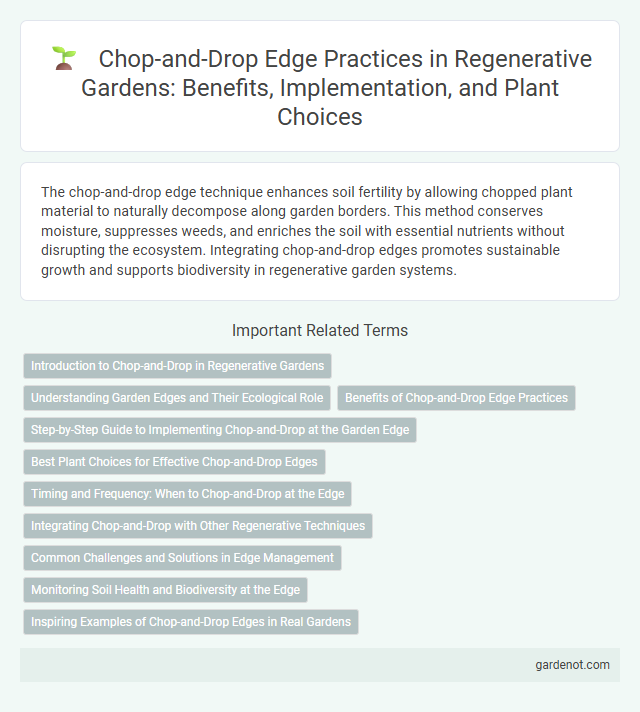The chop-and-drop edge technique enhances soil fertility by allowing chopped plant material to naturally decompose along garden borders. This method conserves moisture, suppresses weeds, and enriches the soil with essential nutrients without disrupting the ecosystem. Integrating chop-and-drop edges promotes sustainable growth and supports biodiversity in regenerative garden systems.
Introduction to Chop-and-Drop in Regenerative Gardens
Chop-and-drop is a regenerative gardening technique where plant biomass is cut and left to decompose on the soil surface, enriching the garden with organic matter and nutrients. This method enhances soil fertility, conserves moisture, and supports beneficial microbial activity without the need for synthetic inputs. Integrating chop-and-drop practices promotes sustainable plant growth and improves overall ecosystem health in regenerative gardens.
Understanding Garden Edges and Their Ecological Role
Chop-and-drop edges in regenerative gardening involve mulching plant material directly at the garden's boundary to enhance soil fertility and support beneficial insect habitats. These edges create transitional zones between cultivated and wild areas, promoting biodiversity and natural pest control by providing shelter and food sources. Maintaining diverse plant species at garden edges optimizes nutrient cycling and strengthens ecosystem resilience.
Benefits of Chop-and-Drop Edge Practices
Chop-and-drop edge practices enhance soil fertility by allowing organic matter to decompose directly on-site, enriching the soil with essential nutrients and improving microbial activity. This method reduces the need for external fertilizers and helps conserve moisture by providing natural mulch that suppresses weeds and retains water. Implementing chop-and-drop techniques at garden edges also promotes biodiversity by creating habitats for beneficial insects and maintaining a healthy ecosystem.
Step-by-Step Guide to Implementing Chop-and-Drop at the Garden Edge
Chop-and-drop at the garden edge involves strategically pruning or cutting perennial plants and immediately dropping the material as mulch to improve soil fertility and moisture retention. Begin by identifying suitable edge plants such as comfrey or dynamic accumulators that benefit from regular harvesting without damage. Consistently layering chopped biomass maintains nutrient cycling, suppresses weeds, and enhances beneficial microbial activity along garden boundaries.
Best Plant Choices for Effective Chop-and-Drop Edges
Chop-and-drop edges thrive with nitrogen-fixing plants like comfrey and pigeon pea, which enrich soil fertility naturally. Dynamic accumulators such as borage and dandelion bring essential minerals to the surface, improving soil health when chopped and dropped. Fast-growing cover crops like mustard and clover provide biomass that protects soil moisture and enhances microbial activity along garden edges.
Timing and Frequency: When to Chop-and-Drop at the Edge
Chop-and-drop at the garden edge is most effective during early growth stages when plants are tender and nutrient-rich, typically in spring or early summer. Frequent pruning every 3 to 6 weeks ensures continuous mulch supply, promoting soil moisture retention and nutrient cycling. Timing these cuts before flowering maximizes biomass quality and supports adjacent plant health through enhanced organic matter.
Integrating Chop-and-Drop with Other Regenerative Techniques
Integrating chop-and-drop with key regenerative techniques like mulching, sheet composting, and companion planting enhances soil fertility by continuously supplying organic matter and nutrients. This method supports natural nutrient cycling, reduces erosion, and promotes beneficial microbial activity, fostering resilient plant growth. Combining chop-and-drop with no-till practices optimizes soil structure and moisture retention for sustainable garden ecosystems.
Common Challenges and Solutions in Edge Management
Chop-and-drop edge management often faces challenges such as uneven decomposition rates and nutrient imbalances due to inconsistent organic matter distribution. Solutions include selecting diverse plant species with complementary decay rates and strategically placing chop materials to ensure uniform soil enrichment. Incorporating mulch layers also helps retain moisture and suppress weeds, enhancing overall edge health in regenerative gardens.
Monitoring Soil Health and Biodiversity at the Edge
Chop-and-drop edges enhance soil health by recycling organic matter directly into the garden's perimeter, promoting nutrient-rich topsoil and improved microbe activity. Regular monitoring of these edges reveals increased biodiversity, including beneficial insects and fungi that support plant growth and natural pest control. Tracking soil pH, moisture levels, and root development at the chop-and-drop interface ensures sustainable regenerative cycling and long-term ecosystem resilience.
Inspiring Examples of Chop-and-Drop Edges in Real Gardens
Chop-and-drop edges create nutrient-rich mulch by strategically trimming plants and allowing the clippings to decompose in place, enhancing soil health and moisture retention. In real regenerative gardens, such as those in permaculture farms across California and Australia, gardeners use native shrubs like rosemary and lavender to form living borders that continuously provide organic matter. This method supports diverse microhabitats, promotes beneficial insect populations, and reduces waste, demonstrating a sustainable approach to garden maintenance.
Chop-and-drop edge Infographic

 gardenot.com
gardenot.com